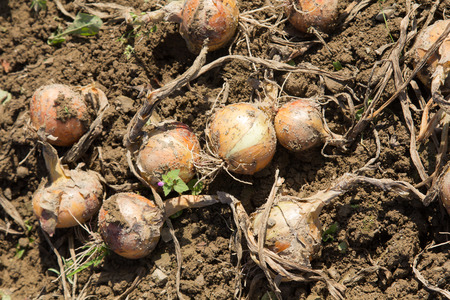There are not many vegetables that are so often used in the kitchen as onions and their smaller milder counterparts the shallots. They can be grown both as a seed grown crop or from sets which are simply small bulbs. Seeds are available in a wider selection of varieties. They also seem to store better and are less prone to bolting (prematurely producing flower heads). For the cash strapped among us they are also cheaper. However, for the beginner, sets can be considerably easier, quicker to provide a crop and less prone to disease and onion fly and less needy of rich soils. Even if you are busy or experiencing poor weather, sets will usually provide a crop even if they go in later than is ideal.
You can plant overwintering onions (often called Japanese onions) in mid September to early November. These will crop in June. These help to fill in a gap in the crop before the main crop matures around a month later.
A neutral to alkaline soil is ideal so if you are gardening on an acidic soil you will need to add garden lime. If you are unsure, cheap soil testing kits are available. Heavy soils can lead to fungal rots, so improve the soil with organic matter. If using manure, leave a gap between adding the manure and starting off the crop to avoid rotting. Always rotate your crops each year to avoid build up of pests and diseases in the soil. Nutrients in the soil should be improved by adding a general purpose fertiliser at the manufacturers recommended rate.
Growing from seed
If growing from seed you will need to start them off earlier than from sets. It is often more successful to sow seed in modules in a heated greenhouse or on a windowsill from January onwards. A temperature between 10-15 degrees centigrade (50-59 degrees Fahrenheit) is ideal. The temperature should not be allowed to rise above this once germination has occurred as this can lead to bolting after the crop has been planted. The seedlings should be hardened off in a cold frame before they are planted out at the same spacing as sets as described below. Seeds can also be sown directly in the soil in early March and thinned, firstly to 2.5-5cm (1-2 inches) and later to 10cm (4 inches).
Growing from sets
Sets can be planted in March or April to crop in mid to late summer. Plant with the fat end down and the tip just above the level of the soil. A good tip is to snip off the loose skin at the top of the set as this will help to prevent birds from pulling up the sets. The sets should be planted at a spacing of 10cm (4 inches), in rows 20-30cm (8-12 inches) apart. Smaller onions will result from closer spacing. A wider spacing is only required if you wish to grow giant onions to show. Shallots grow in clusters of small bulbs and therefore require wider spacing at around 15cm (5 inches) in rows 30cm (12 inches) apart, and should be planted earlier just before spring. A small hole should be scraped and the set planted into it. Backfill the soil around it. Frost can lift the sets, as can the birds. A cloche or netting may be required until the plants are established.
With both methods the plants should be watered in dry spells and the soil kept as free of weeds as possible.
Harvesting
Harvesting time is usually mid to late July for shallots and early to late summer for onions. Wait until the foliage is yellowing and bent over before harvesting. They can be lifted earlier if you need them, but they should be used straight away as they will not store well. The bulbs should be gently levered underneath with a fork and pulled. The onions and shallots will need to be dried for between a week and three weeks. They can be left to dry on the soil surface in the sun or placed on a rack with good air circulation outdoors. They will need to be covered in wet weather. To store the bulbs, keep them in net bags or string them up and hang them in a cool dark place. The spread of rot can be avoided by removing any infected bulbs.
Problems
Bolting is fairly common. When the plant sends up a premature flower shoot the stem should be removed. These bulbs should be used first as they may not store well. It is often caused by early sowings or planting in a cold spring.
The soil pest eelworm can be detected from swollen and distorted foliage. This will lead to soft unusable bulbs. The build up of eelworm can be avoided by good crop rotation.
The failure of plants to develop can be due to onion fly. This is where small maggots eat the base of the bulb. Sets are less prone to this than seed grown plants. Covering with fleece or a cloche until the plants are well established helps to prevent this. Badly affected plants should be lifted and destroyed.
In prolonged periods of wet mildew may occur. Infected leaves should be removed, but the bulbs may not store well.
White rot is a much more serious problem. This can be detected from yellowing and wilting foliage and fluffy white growths at the bulbs base. Destroy the infected plants and avoid growing onions in the same area for eight years after the problem has occurred, or grow in raised beds with bought in soil.
Various other problems may occur, but don’t be put off, just give it a go and learn from your mistakes.
To view onion sets at Thompson & Morgan click here
Mark Snelling
If you have enjoyed reading our blog post then why not fill in the form provided to allow us to send you our blog posts and newsletters by email.



